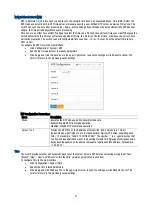
9
IGMP packets in order to reduce load on the multicast router
MLD v1/v2 Snooping
Delivers IPv6 multicast packets only to the required receivers
Device Management System (DMS)
Graphical Monitoring
Topology view: Support intuitive way to configure and manage
switches and devices with visual relations
Floor view: It’s easy to drag and drop PoE devices and help you to build
smart workforces
Map view: Enhance efficiency to drag and drop devices and monitor
surroundings on google map
Traffic Monitoring
Display visual chart of network traffic of all devices and monitor every port
at any time from the switch.
Trouble Shooting
Network diagnostic between master switch and devices
Support protection mechanism, such as rate-limiting to protect your
devices from brute-force downloading
Layer 3 Switching
IPv4 Static Routing
IPv4 Unicast: Static routing
IPv6 Static Routing
IPv6 Unicast: Static routing
Security
Secure Shell (SSH)
SSH secures Telnet traffic in or out of the switch, SSH v1 and v2 are
supported.
Secure Sockets Layer (SSL)
SSL encrypts the HTTP traffic, allowing advanced secure access to the
browser-based management GUI in the switch.
IEEE 802.1X
IEEE802.1X: RADIUS authentication, authorization and accounting,
MD5 hash, guest VLAN, single/multiple host mode and single/multiple
sessions
Supports IGMP-RADIUS based 802.1X
Dynamic VLAN assignment
Layer 2 Isolation Private VLAN Edge
PVE (also known as protected ports) provides L2 isolation between clients in
the same VLAN. Supports multiple uplinks.
Port Security
Locks MAC addresses to ports and limits the number of learned MAC
addresses
IP Source Guard
Prevents illegal IP address from accessing to specific port in the switch.
RADIUS/
Supports RADIUS and authentication. The switch as client
Storm Control
Prevents traffic on a LAN from being disrupted by broadcast, multicast, or
unicast storm on a port.
DHCP Snooping
A feature acts as a firewall between untrusted hosts and trusted DHCP
servers
ACLs
Supports up to 256 entries. Drop or rate limitation based on:
Source and destination MAC, VLAN ID or IP address, protocol, port,
Differentiated services code point (DSCP) / IP precedence
TCP/ UDP source and destination ports
802.1p priority
Ethernet type
Internet Control Message Protocol (ICMP) packets
TCP flag
Quality of Service
Hardware Queue
Supports 8 hardware queues
Scheduling
Strict priority and weighted round-robin (WRR)
Queue assignment based on DSCP and class of service

























